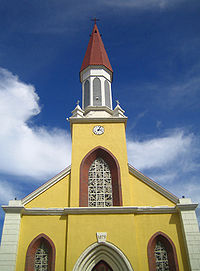Notre Dame Cathedral, Papeete
| Notre Dame Cathedral Cathédrale de Papeete Notre-Dame de L'Immaculée Conception (in French) | |
|---|---|
| Cathedral of Our Lady of the Immaculate Conception of Papeete | |
 Notre Dame Cathedral, Papeete | |
 | |
| 17°32′25″S 149°34′1″W / 17.54028°S 149.56694°W | |
| Location | Rue du Général de Gaulle, Papeete |
| Country | |
| Denomination | Roman Catholic |
| History | |
| Status | Cathedral |
| Consecrated | |
| Architecture | |
| Functional status | Active |
| Groundbreaking | |
| Completed | 1875 |
| Administration | |
| Archdiocese | Roman Catholic Archdiocese of Papeete |
| Clergy | |
| Archbishop | Vacant |
Notre Dame Cathedral (French: Cathédrale de Papeete Notre-Dame de L'Immaculée Conception) is a late 19th-century church that serves as the cathedral of the Roman Catholic Archdiocese of Papeete. It is located close to the waterfront esplanade of the capital city on the rue du Général de Gaulle.
The construction of the cathedral began in the middle of the 19th century and it opened in 1875. It is the oldest Catholic church in Tahiti[1] and one of Papeete's last remaining examples of early colonial architecture.[2]
History
[edit]In the 19th century, France began expanding its colonial empire into Asia and the Pacific Islands, declaring the Kingdom of Tahiti a protectorate in 1842.[3] French missionaries began arriving in the same year[4] and an apostolic vicariate was established on May 9, 1848.[5] Construction of the cathedral most likely started after this time and it was completed in 1875.[1] Named after its famous Parisian counterpart,[6] the cathedral was built near the waterfront in midtown Papeete.[2][7]
Architecture
[edit]Exterior
[edit]The entrance of the cathedral features a red steeple[8] at the centre that faces towards Mount Aorai.[9]
Interior
[edit]The interior of the church is noted for its mixture of European and local Polynesian features in its design. This is demonstrated in a full-size woodcarving of the Madonna and Child, the latter of whom is clutching a breadfruit. This work of art originated from the Marquesas Islands.[1]
The cathedral is also known for its artistic representations of the Stations of the Cross. Created by Yuel Durnad and St. Fond,[10] the stations incorporate both Tahitian and Roman cultures in the style of dress, but solely depict Polynesian people in the scenes of The Passion. The artistic style of the paintings was influenced by Paul Gauguin.[9]
References
[edit]- ^ a b c Goodwin, Bill (November 2, 2010). Frommer's Tahiti and French Polynesia. John Wiley & Sons. p. 99. ISBN 9780470947388. Retrieved March 21, 2013.
- ^ a b Borthwick, John (February 3, 2013). "The joys of lei Paris". The Sun Herald. p. 16. Retrieved March 22, 2013. (subscription required)
- ^ White, Owen; Daughton, J.P., eds. (September 27, 2012). In God's Empire: French Missionaries in the Modern World. Oxford University Press. pp. 218–219. ISBN 9780195396447. Retrieved March 22, 2013.
- ^ Melton, J. Gordon; Baumann, Martin, eds. (September 21, 2010). Religions of the World, Second Edition: A Comprehensive Encyclopedia of Beliefs and Practices. ABC-CLIO. p. 1153. ISBN 9781598842043. Retrieved March 22, 2013.
- ^ "Archdiocese of Papeete". Catholic-Hierarchy.org. Catholic-Hierarchy. Retrieved March 22, 2013.
- ^ "Hidden jewels of French Polynesia". The Canberra Times. February 18, 2012. Retrieved March 22, 2013. (subscription required)
- ^ Hillinger, Charles (August 18, 1974). "Beer Big Business in Tahiti". The Victoria Advocate. Retrieved March 22, 2013.
- ^ Cruz, Georgina (February 3, 2013). "Footloose, fancy-free in French Polynesia". The Stuart News. p. 2. Retrieved March 21, 2013. (subscription required)
- ^ a b Stanley, David (August 26, 2003). Moon Handbook Tahiti: Including the Cook Islands. David Stanley. p. 129. ISBN 9781566914123. Retrieved March 21, 2013.
- ^ Peterson, Austin (February 7, 2003). Tahiti Report 2003: An Intimate Tour Around Tahiti and Moorea. iUniverse. p. 4. ISBN 9780595268351. Retrieved March 22, 2013.
